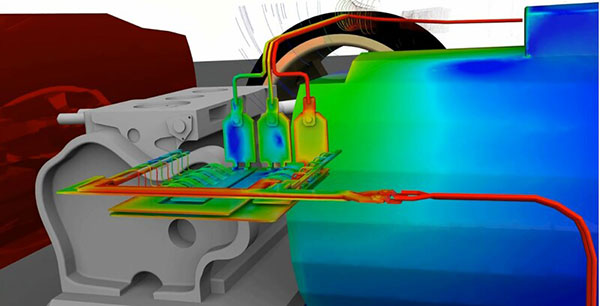Ansys 2023 R2 Unveiled for Simulation, Digital Engineering
New release designed to equip organizations with advanced physics solvers, scalable GPU-based computing and workflows.

In Ansys 2023 R2, a full EV power electronics electrothermal workflow provides solutions from power IC, to package, to board with Ansys SIwave-CPA and Ansys Q3D Extractor (pictured). Image courtesy of Ansys.
Latest News
August 1, 2023
The latest release from Ansys, 2023 R2 combines a range of enhanced numerics capabilities, performance improvements and cross-disciplinary engineering solutions to equip organizations with advanced physics solvers, scalable GPU-based computing and workflows.
“From semiconductor manufacturers to electric vehicle makers and autonomous aircraft developers, our latest software release empowers these organizations with scalable digital engineering workflows that are critical to digital transformation,” says Shane Emswiler, senior vice president of products at Ansys. “Virtual design and development is at the forefront of transformational innovation within leading organizations across industries, and we are helping to make this a reality.”
Collaborate with Digital Engineering
All major semiconductor foundries have certified Ansys solutions for their most advanced technology nodes, and Ansys electrothermal solutions are essential to reliable 3D-integrated circuit design. The latest updates to Ansys RedHawk-SC, a multiphysics sign-off solution for semiconductors, significantly accelerate thermal analysis workflows. A complete electromagnetic simulation and modeling chain for IC design integrates the Ansys High Frequency Structure Simulator (HFSS), Ansys Q3D Extractor parasitic extraction analysis, and the Ansys RaptorX EM solver.
Additionally, Ansys EMC Plus (formerly Ansys EMA3D Cable) now offers a full electromagnetic compatibility (EMC) workflow. New, integrated features in 2023 R2 enable engineers to meet high-tech challenges with complex product requirements.
“From semiconductor manufacturers to electric vehicle makers and autonomous aircraft developers, our latest software release empowers these organizations with scalable digital engineering workflows that are critical to digital transformation,” says Shane Emswiler, senior vice president of products at Ansys. “Virtual design and development is at the forefront of transformational innovation within leading organizations across industries, and we are helping to make this a reality.”
Specific industry sectors like healthcare, automotive, and aerospace also benefit from Ansys digital engineering workflows in 2023 R2. A full EV power electronics electrothermal workflow provides solutions from power IC, to package, to board with Ansys SIwave-CPA for signal integrity, power integrity, and EMI analysis, and the Ansys Q3D Extractor parasitic extraction tool. EV designers can also use simulation to visualize sound sonograms and model brand-defining acoustics with an integrated Ansys Motion and Ansys Sound workflow.
Engineers in aerospace and defense, as well as automotive industries, can benefit from the new digital safety collaboration platform in Ansys medini analyze 2023 R2, which serves as a central safety project hub across an organization. A new Ansys Digital Safety Manager Web app replaces the existing desktop client, enabling centralized planning, monitoring, and validation of medini safety and cybersecurity projects.
Speed Simulation with Large-scale Computing
Ansys 2023 R2 enables users to run large jobs and help overcome hardware capacity limitations with high-performance computing (HPC), both on-premises and in the cloud. Enhanced solver algorithms capitalize on GPUs to speed simulation. In Ansys 2023 R2, the Fluids product line enables additional industrial simulations to run natively on GPUs, substantially reducing solve time and total power consumption. For example, 2023 R2 extends multi-GPU support to sliding mesh, compressible flows, and eddy dissipation model combustion simulations. That means analysis of internal combustion engines, centrifugal pumps and fans, turbochargers and compressors, stirred tanks and reactors, and hydraulic machinery can now be supercharged with the Ansys Fluent multi-GPU solver
The Ansys Discovery simulation-driven 3D design tool is more predictively accurate with live structural physics while reducing GPU memory requirements for thin structures. Subdivision geometry modeling in Discovery provides a new way to create and edit complex parts, enabling users to see the results of “what-if” changes almost instantly for many popular CAD models. Discovery has grown from providing four features in 2019 to 50 in 2023 R2, including turbulence models, electromagnetics, and manufacturing constraints.
Ansys Speos optical system design software also uses GPU acceleration. Optical simulations that use ray tracing are now fully supported. Speos also supports 3D irradiance with GPU acceleration. At the photon level, Ansys Lumerical simulation tools have a new Express Mode in the finite difference time domain (FDTD) solver that enables users to run simulations with NVIDIA GPUs.
To learn more about Ansys 2023 R2, visit ansys.com/products/release-highlights.
Sources: Press materials received from the company and additional information gleaned from the company’s website.
More Ansys Coverage
Subscribe to our FREE magazine, FREE email newsletters or both!
Latest News
About the Author
DE’s editors contribute news and new product announcements to Digital Engineering.
Press releases may be sent to them via DE-Editors@digitaleng.news.






